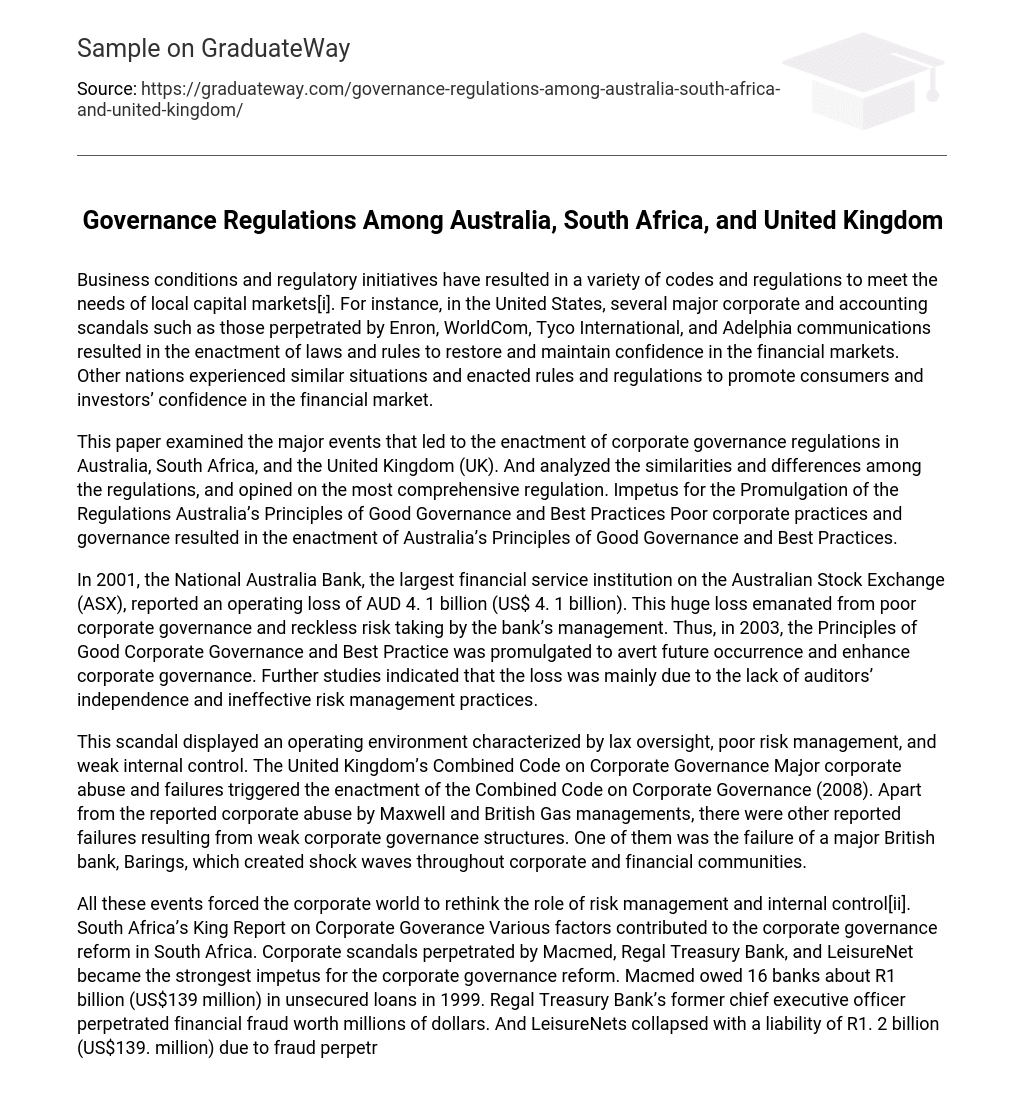Multiple codes and regulations have been established in order to address the requirements of domestic capital markets[i] in response to business conditions and regulatory initiatives. In the United States, for instance, legislation and rules were introduced to rebuild and maintain trust in financial markets after scandals involving Enron, WorldCom, Tyco International, and Adelphia communications. Similar actions were taken in other countries through the development of regulations aimed at fostering confidence among consumers and investors within the financial market.
This paper examines the implementation of corporate governance regulations in Australia, South Africa, and the United Kingdom (UK). It discusses the events that led to these regulations and compares their similarities and differences. Additionally, it provides an assessment of which regulation is the most comprehensive. The introduction of Australia’s Principles of Good Governance and Best Practices was a response to insufficient corporate practices and governance.
In 2001, the National Australia Bank reported an operating loss of AUD 4.1 billion as a result of poor corporate governance and reckless risk taking by the bank’s management. To prevent similar incidents and improve corporate governance, the Principles of Good Corporate Governance and Best Practice were introduced in 2003. Subsequent research revealed that the loss was primarily attributed to the absence of auditors’ independence and inadequate risk management strategies.
This scandal revealed a working atmosphere that had lax oversight, inadequate risk management, and weak internal control. The enactment of the Combined Code on Corporate Governance (2008) in the United Kingdom was prompted by major corporate abuse and failures. Other instances of weak corporate governance structures led to reported failures, such as the collapse of Barings, a major British bank, which sent shockwaves across the corporate and financial sectors.
The role of risk management and internal control was forced to be reconsidered in the corporate world due to various events. These events included corporate scandals committed by Macmed, Regal Treasury Bank, and LeisureNet, which became the main driving force behind the reform of corporate governance in South Africa. In 1999, Macmed was indebted to 16 banks for approximately R1 billion (US$139 million) in unsecured loans. The former CEO of Regal Treasury Bank engaged in financial fraud worth millions of dollars. Additionally, LeisureNet collapsed with a liability of R1.2 billion (US$139 million) as a result of fraud committed by its executive officers.
These events ultimately led to the creation of the King Report on Corporate Governance. The market also played a significant role in driving the reform, as declining equity prices prompted changes in corporate behavior and structure. As previously mentioned, unfavorable business conditions, corporate failures, and misconduct were the primary motivators for governance regulations in Australia, South Africa, and the UK. After reviewing and comparing the regulations, we identified several similarities and differences among them.
The governance regulations in different countries share similarities. They include provisions to strengthen the internal control system, such as ensuring the independence of external auditors through measures like mandatory rotation of audit partners and restrictions on non-audit services. In the UK, for example, the audit committee oversees the effectiveness of the internal audit function and assesses the need for it annually, providing recommendations to the board.
The committee also presents the reasons for the absence of an internal audit function in its annual report10. The chief executive officer and the chief financial officer are required to certify annual/quarterly financial reports and provide assurance for the effectiveness of internal controls[iv]. For instance, the Combined Code in the UK specifies that the board should conduct an annual review of the group’s internal control system and report it to shareholders. • Measures to enhance the independence and objectivity: Enhancing the independence of audit committees and their effectiveness[v].
The audit committee in South Africa requires the chairperson to be an independent non-executive director and not hold the position of board chair. However, the board chair can attend meetings upon request from the audit committee chair3. Additionally, there must be regulations in place to disclose off-balance sheet transactions and the use of pro forma financial information. Furthermore, public companies are obligated to promptly disclose major changes in their financial situation or operations[vi].
Companies in Australia are mandated to implement mechanisms to ensure compliance with ASX Listing Rule requirements. This is essential for enabling investors to obtain access to vital information about listed companies, including their performance, ownership, and governance.
There are several differences between these three countries in terms of governance regulations. Australia places a greater emphasis on objectivity and ethical matters compared to the other two countries. It specifically outlines the objective of effective internal auditing, which is to add value to the corporation, and underscores the significance of ethics in decision-making and financial reporting.
In the UK, more attention is given to corporate remuneration and the regular meetings of audit committees. The UK code stipulates that audit committees must meet privately with the Chief Audit Executive (CAE) at least once a year. In contrast, Australian regulations do not provide detailed requirements for such meetings.
In South Africa, the board is required to follow the ‘apply or explain’ approach in collective decision-making. This approach helps to clarify how the principles and recommendations were either implemented or disregarded.
Based on our review, we conclude that Australia has the most comprehensive governance requirements among these countries.
The ASX’s Corporate Governance Council has issued 10 Principles of Good Corporate Governance and Best Practice Recommendations. Two significant requirements include the Disclosure Requirement, which mandates that listed companies disclose in their annual reports how they adhere to the principles and recommendations, as well as what they do not follow. Additionally, the Audit Committee Requirement stipulates that all listed companies must have an audit committee to oversee risk management and control.





